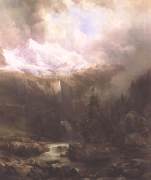

The most important feature of Hungarian romanticist landscape painting is that it makes viewers feel involved. Hungarian landscape painters portrayed romantic details of Hungarian landscape, mountains (Miklós Barabás:Rumanian Family Setting out for the Fair, 1843-44), waterfalls (Gusztáv Keleti: Landscape in the Tatra Mountains with Waterfall, c. 1860), Lake Balaton (Brodszky Sándor: Storm at the Lake Balaton, c. 1870), the endless plain which expresses the desire for freedom (Károly Markó the Elder: View of the Great Hungarian Plain with Draw Well, 1853; The Puszta, 1853; Károly Lotz: Stud in a Thunderstorm, 11862, etc.). Artists were interested in ruins of national history rather than those of ancient times (Károly Telepy: Diósgyőr, 1860; Antal Ligeti: Visegrád, 1860) and some certain landscapes. Thus, subject matters influence emotions of viewers.
Although Hungarian painters were always pleased to go to Italy during the time of romanticism, their attraction was drawn to a new set of motifs, e.g. instead of generalisation, they turned to individual characters of subject matters (Károly Telepy: Carthusian Monastery in the Vicinity of Rome, c. 1858). The same applies to Hungarian artists travelling to the Orient in search of exotic motifs ( Antal Ligeti: Oasis, 1862; Ligeti Antal: Lebanon and Anti-Lebanon, 1855-60, or Károly Lajos Libay: Regensburg, 1849) who extended the world in their art in a way never witnessed before, thus opening new perspectives for painting.